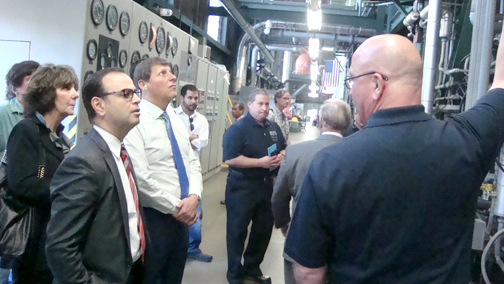
Glendale City Councilmembers Zareh Sinanyan, left forward, Paula Devine and Ara Najarian listened to a member of the Grayson Power Plant explain the machinations of the plant during a “workboot” meeting.
By Jason KUROSU
On Tuesday, the Glendale City Council held the afternoon session of its regular meeting at the Grayson Power Plant, the first of a series of “workboot” meetings in which the members of the council receive a firsthand look at how various departments operate, an effort city officials hope will generate more informed policy.
Tuesday’s meeting centered around the potential revamping of much of the Grayson Power Plant, which officials say provides up to 15% of the city’s power and houses turbines as old as 1941. Many others date to the ’50s and ’60s, with the most recent gas turbine-generator installed in 2003, replacing two retiring units.
Glendale Water & Power Director Steve Zurn touted the reliability of Glendale power, but emphasized that there were challenges to overcome due to aging infrastructure within the plant.
Though Zurn said that outages were a rarity for customers, he said there were outages within the plant as well as costly maintenance issues leading to cost ineffectiveness and old parts needing replacement.
The city council will be presented with a study titled the Integrated Resource Plan (IRP) in March, which Zurn said will determine what energy needs the city is facing, including whether or not to repower Grayson. Replacing Grayson’s turbines is a project that could cost up to $350 million.
Zurn stressed the importance of being able to generate local power, calling Grayson’s ability to maintain power when separated from Los Angeles Water & Power “a godsend” and “invaluable.”
“When the power through L.A. has been affected either by some natural disaster or a mistake on the part of an individual and we get cut off from that service provision, we are able to use Grayson to make up for that.”
Zurn said that Grayson aided the city of Glendale in recovering from and in some cases preventing outages during the 1994 Northridge Earthquake, 2005 L.A. Basin blackout, Sylmar Fire and other similar events that generally affect utilities.
Zurn also said that repowering the plant would reduce the ecological footprint of the plant to one-third of its current output, decrease the amount of time required to produce power and reduce the cost of purchasing power from the city of Los Angeles.
After the general meeting, members of the city council and the general public were taken on a tour of the plant, led by Glendale Water & Power employees. City council members were made privy to how power is generated and distributed throughout the city.
Glendale City Manager Scott Ochoa said the workboot meetings would be a boon to both the council and the public, especially when concerning capital improvement projects potentially costing millions of dollars.
“As we move forward with the IRP, the council is going to have to make decisions about what to do with the future of power generation and that means understanding how this particular, very large piece of infrastructure works,” Ochoa said.
The Glendale City Council will be participating in more monthly workboot meetings. Next month, they will consult with the Glendale Police Dept. on traffic safety. In the coming months, the council will visit with emergency and fire services at Glendale Memorial Hospital, recycling services at a local landfill and the parks department.
